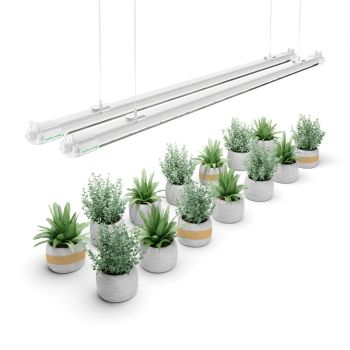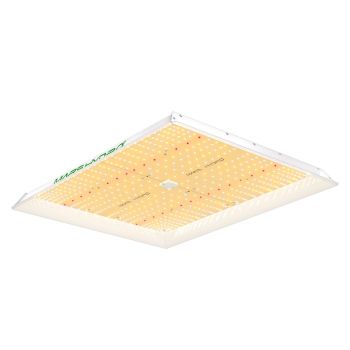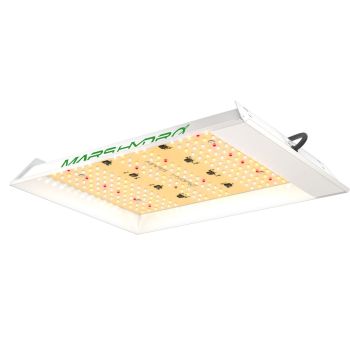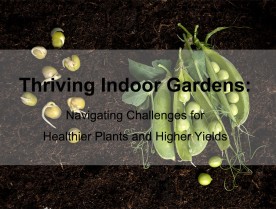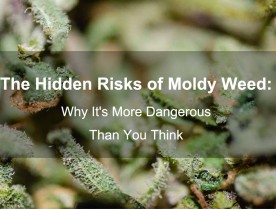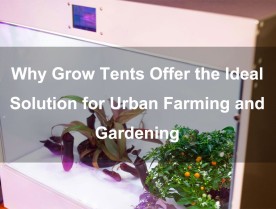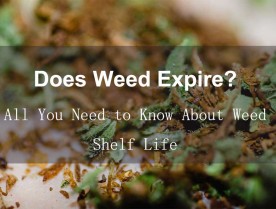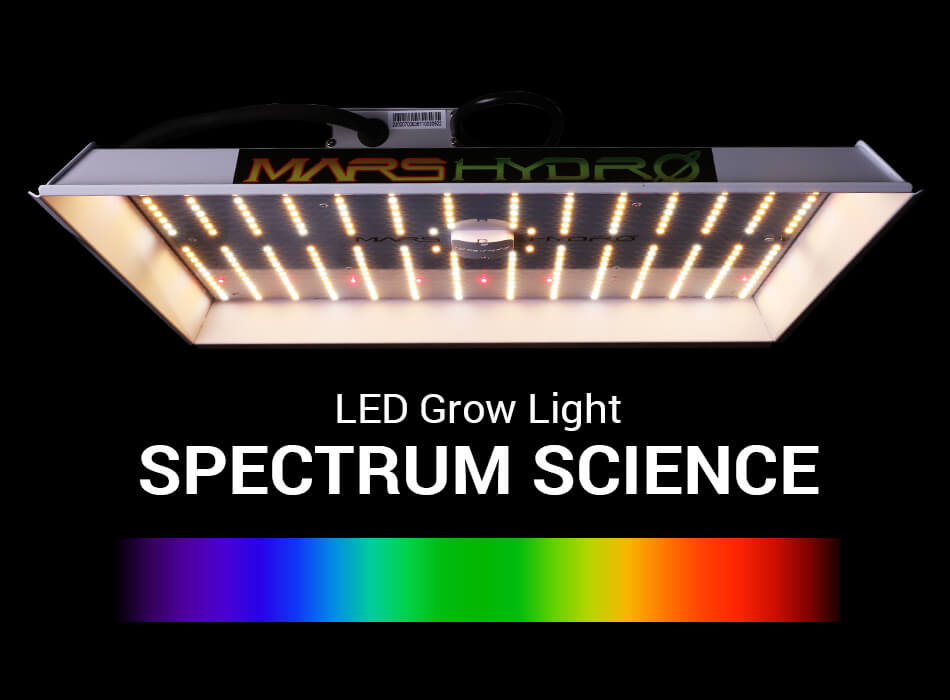
As indoor gardening continues to grow in popularity, LED grow lights have become a vital tool for achieving healthy and bountiful plants. By providing the optimal spectrum of light, these lights allow gardeners to cultivate vibrant plants all year round. However, with so many different types of LED grow lights available, navigating the world of spectrum science can be overwhelming.
That's why we've created this comprehensive guide. We hope this guide will equip you with the knowledge and tools necessary to select the ideal spectrum for your plants, give you some ideas on what LEDs your garden needs, and grow thriving plants all year round. So, let's dive into the fascinating world of LED grow light spectrum science!
Light Spectrum and Visible Light Spectrum
Light Spectrum, refers to the entire range of wavelengths of electromagnetic radiation that we can perceive as light, including both visible and non-visible light. This spectrum extends from gamma rays, which have the shortest wavelengths and the highest energy, to radio waves, which have the longest wavelengths and the lowest energy.

The visible light spectrum, which is part of the spectrum that our eyes can detect, ranges from about 380 to 750 nanometers in wavelength and is commonly referred to as the "rainbow" of colors, from violet to red.
Other parts of the spectrum, such as ultraviolet (UV) and infrared (IR) radiation, are not visible to the human eye but have important applications in various fields.
Visible Light Spectrum and Plant Photosynthesis
During photosynthesis, plants use the energy from sunlight to convert carbon dioxide and water into glucose and oxygen. However, only certain wavelengths of light are effective for photosynthesis.

Essential Pigments in Photosynthesis Process
Chlorophylls are responsible for absorbing light energy during photosynthesis and are the most important pigments in the process. They are green pigments that are found in the chloroplasts of plant cells and absorb light most efficiently in the blue and red regions of the visible spectrum. Chlorophylls are divided into two main types, chlorophyll A and chlorophyll B, which differ slightly in their absorption spectra.
Chlorophyll A primarily absorbs light in the blue-violet and red regions of the visible spectrum, with peak absorption occurring at around 430 nm and 660 nm. Chlorophyll B, on the other hand, absorbs light in the blue and orange regions of the visible spectrum, with peak absorption occurring at around 450 nm and 640 nm. Together, these two pigments absorb light across a wide range of wavelengths, enabling plants to efficiently capture energy from sunlight and convert it into chemical energy through photosynthesis.
Carotenoids are also important pigments in photosynthesis and are responsible for helping to protect chlorophyll from damage by absorbing excess light energy and dissipating it as heat. They absorb light in the blue and green regions of the spectrum. They are yellow, orange, or red pigments and are found in the thylakoid membranes of chloroplasts.
Together, chlorophylls and carotenoids work to absorb light energy during photosynthesis and convert it into chemical energy that can be used by the plant.
Chlorophyll and Visible Spectrum Light
As mentioned above, Chlorophyll A absorbs light in the violet-blue and red parts of the visible spectrum, with absorption peaks at approximately 430 nm and 662 nm. Its absorption range is from 400-450 nm and 650-700 nm, which includes blue and red light.
While Chlorophyll B absorbs light in the blue and orange parts of the visible spectrum, with absorption peaks at approximately 453 nm and 642 nm. Its absorption range is from 400-500 nm and 600-700 nm, which includes blue and yellow-green light.
This means that the most significant energy for Photosynthesis comes from the visible light spectrum, and mainly from red, blue, and yellow-green light. So what are their effects on plant growth and development? Do other wavelengths also contribute to the process?
The Effect of Various Colors of Light on Plant Growth
For plants to grow and develop optimally, it is essential to provide them with specific light requirements. Sunlight, consisting of the full spectrum of colors, affects plant growth differently depending on the color of light.
Blue Light (450-490 nm)

Blue light, approximately 450 to 490 nanometers (nm) in wavelengths, is one of the most important spectra for plant growth and development. It is characterized by a short wavelength and high energy. Specifically, Blue Light stimulates the production of chlorophyll, plays a vital role in leaf development and stem elongation, helps plants establish strong and healthy root systems, helps regulate the opening and closing of stomata, and influences phototropism.
How does it do this work? Blue light regulates these processes by stimulating the production of auxins, which are plant hormones responsible for cell elongation and division, as well as cell differentiation.
Auxins are primarily produced in the plant's apical meristem, which is the growing tip of the plant, and then accumulate on the shaded side of the plant. Therefore, they help plants' growing tips (mainly roots and leaf tips) grow towards sources of water and nutrients and help cell elongation on the shaded side of the plant stem, causing the stem to bend towards the light source. Because it's also responsible for cell division, it helps the leaf to grow larger and thicker.
Besides, Blue light triggers the opening of stomata by activating specific receptors in the guard cells surrounding the stomata, allowing for the uptake of carbon dioxide and release of oxygen, and water vapor loss through transpiration.
Researchers at the University of Florida conducted a study where they grew lettuce seedlings under different light conditions, including blue light. They found that the lettuce seedlings grown under blue light had significantly larger and greener leaves compared to those grown under red or white light. The blue light also promoted stem elongation, resulting in taller and more slender plants.
Green Light (495-570 nm)

The green light has a wavelength range of approximately 495-570 nanometers (nm), making it one of the middle wavelengths in the visible light spectrum.It is, in contrast to what was previously promoted by purple grow light suppliers, part of the visible spectrum that plants can use for photosynthesis, although it is less efficient than red and blue light.
While green light is not as important for plant growth as other colors, it still plays a role in various physiological processes. Studies have shown that green light can enhance plant growth and development by regulating plant architecture, increasing biomass accumulation, promoting flowering in several plant species, as well as stimulating the production of secondary metabolites in plants, which are compounds that contribute to plant defense mechanisms.
Green light takes part in regulating plant architecture by promoting the growth of shoots, leading to taller and more slender plants, while inhibiting root growth. This can be beneficial in certain situations, such as in hydroponic or aeroponic systems, where plants may experience limited space for root growth.
On the other hand, green light penetrates deeper into the plant canopy than other wavelengths, reaching lower leaves that may otherwise be shaded to increase the photosynthetic activity of these lower leaves, leading to greater biomass accumulation.
Green light also affects the levels of certain plant hormones, such as chlorophyll (used in Photosynthesis), cytokinins and gibberellins (regulate flowering time), jasmonic acid (used in plant defense against herbivores and pathogens)
On top of that, green light is a crucial role in stimulating the production of secondary metabolites in plants including flavonoids, phenolic acids, and carotenoids, which are compounds that are not directly involved in plant growth but play a crucial role in plant survival and response to environmental stresses and have potential applications in medicine and industry.
Yellow Light (570-590 nm)

While yellow light, approximately 570-590 nanometers (nm), is a part of the visible spectrum of light that plants can absorb, it is less effective in driving photosynthesis.
However, although yellow light alone may not have a significant effect on plant growth, it can interact with other wavelengths of light to modulate plant growth responses. For example, studies have shown that a combination of blue and yellow light can promote root elongation in Arabidopsis thaliana seedlings, while a combination of red and yellow light can enhance photosynthetic pigment accumulation in lettuce leaves.
Additionally, yellow light may also be active in triggering plant responses to environmental stresses, such as drought and salinity. For instance, exposure to yellow light has been shown to increase the resistance of tomato plants to high salinity stress.
While the precise role of yellow light in plant growth and development is not fully understood, it may have important implications for optimizing plant growth and production in various agricultural settings.
Orange Light (590-620 nm)

Orange light, approximately 590-620 nanometers (nm), while may not be as critical for plant growth and development as red and blue light, can still play an important role in promoting healthy and productive plants and contribute to various physiological processes in plants grow.
Studies have shown that orange light can have a positive effect on the growth and development of certain plants, including tomatoes, lettuce, and strawberry. For example, one study found that supplementing red and blue light with orange light led to an increase in plant height, leaf number, and fresh weight of lettuce seedlings compared to red and blue light alone. Another study found that exposure to orange light increased the number of flowers and fruits produced by tomato plants.
Not as much research has been done on orange light as on red or blue light. However, studies have indicated that orange light can be a big boost when combined with other spectra.
Red Light (620-750 nm)

Red light, approximately 620 to 750 nanometers (nm) in wavelength, is an important wavelength for plants, as it is a major driver of photosynthesis and growth.
Absorbed by a pigment called phytochrome, which exists in two interconvertible forms: Pr (red light-absorbing form) and Pfr (far-red light-absorbing form), red light activates various genes to trigger the germination process breaking the dormancy of seeds, to regulate the circadian clock, the photoperiodism and the production of florigen for inducing flowering, to encourage the production of auxin to promote root growth and stem elongation, to issue signals for the shade avoidance response for making plants grow towards the light source, and to stimulate the production of antioxidants and other protective compounds in plants, helping them to cope with environmental stresses such as high light and high temperature.
One of the critical genes activated by Pfr (far-red light-absorbing form) is gibberellin biosynthesis, which is a hormone that stimulates seed germination. Gibberellin biosynthesis is only activated in the presence of both red light and water, which is why seeds will only germinate under appropriate conditions of light and moisture.
When red light wavelengths are absorbed by phytochromes, which are photoreceptor proteins found in plants, they stimulate the production of auxins, a class of plant hormones that promote cell elongation and expansion. (we've mentioned them in the "Blue Light" section")
In long-day plants, red light acts as a "floral inducer," promoting the expression of genes that initiate flower development. In short-day plants, red light inhibits the expression of genes that repress flowering, thereby allowing flower development to occur.
When a plant is shaded by nearby vegetation, it detects changes in the ratio of red to far-red light in its environment. This is because red light is absorbed by chlorophyll in leaves and far-red light is reflected back by leaves. When a plant is in the shade, it receives less red light and more far-red light compared to when it is in full sunlight. This change in light quality triggers a series of physiological responses in the plant known as the shade avoidance response. One of the main effects of the shade avoidance response is stem elongation.
The red light spectrum is so critical that we do not have enough paragraphs to discuss it in detail. However, we welcome more exploration of it for those who are interested.
Are Ultraviolet Light and Infrared Light Good For Plants?
Ultraviolet light (UV) and infrared light (IR) are two types of electromagnetic radiation that have different effects on plants.

Ultraviolet Light (10-400 nm)
UV light is high-energy radiation. The wavelength range of ultraviolet (UV) radiation is generally considered to be between 10 nanometers (nm) and 400 nm. However, this range can be further divided into three categories: UVA (315-400 nm), UVB (280-315 nm), and UVC (100-280 nm).
UV radiation can have both positive and negative effects on plants, depending on the intensity and duration of exposure. In moderate doses, UV radiation can stimulate the production of secondary metabolites, such as flavonoids and anthocyanins, which can act as antioxidants and protect plants from UV damage. These compounds can also enhance the nutritional and medicinal value of crops.
However, high levels of UV radiation can be damaging to plant tissues by causing mutations in DNA and inhibiting photosynthesis. This can result in reduced growth and yield, as well as increased susceptibility to diseases and pests. In extreme cases, excessive UV radiation can even cause cell death and plant mortality.
Infrared Light (700 nm -1000 mm)
IR light is a low-energy radiation that can penetrate deeper into plant tissues and stimulate stem growth and flowering. The wavelength range of infrared (IR) radiation is between 700 nm and 1 millimeter (mm), which can be further divided into three categories: near-infrared (NIR, 700-1400 nm), mid-infrared (MIR, 1400-3000 nm), and far-infrared (FIR, 3000 nm - 1 mm). In plant cultivation, NIR is more common to see.However, too much IR light can also overheat plant cells and cause wilting or burning.
Infrared (IR) light can also have a significant impact on plant growth and development. Unlike ultraviolet light, infrared light has a longer wavelength.
One of the best-known effects of IR light is its ability to raise the temperature of plant tissue, which can stimulate metabolic processes and improve plant growth. This is known as the 'thermal effect' of infrared light. Infrared light can also influence the opening and closing of stomata, thus regulating water loss and gas exchange in plants.
In addition, infrared light can also influence various developmental processes in plants. For example, studies have shown that infrared light can stimulate stem elongation, increase leaf size and thickness, and promote flowering in some species. Infrared light can also influence the production of plant hormones such as auxin, gibberellins and cytokinins, which play an important role in regulating plant growth and development.
Both UV light and IR light are critical "information spectrums" for plants. They're now widely applied in agricultural production and medical production. Check out our guide on How To Use UV and IR for more practical usage for your gardens.
Can Ultraviolet and Infrared Light be seen with human eyes?
No, ultraviolet and infrared light cannot be seen with human eyes as they are outside the visible spectrum of light. The human eye can only detect a range of wavelengths from about 400 to 700 nanometers, which corresponds to the colors violet, blue, green, yellow, orange, and red. Ultraviolet light has a shorter wavelength than violet light and infrared light has a longer wavelength than red light, making them both invisible to human eyes.
Thenwhy on some led grow lights, do the UVdiodes and IR diodes have color? On some LED grow lights, the UV and IR diodes may have a color coating even though they are not visible to the human eye. This is because the coating serves a different purpose than simply indicating the color of the light. The coating may protect the diodes from damage or help with heat dissipation. Additionally, the coating may help to differentiate the UV and IR diodes from the visible light diodes, making it easier to identify which diodes are producing which type of light. If you find there are some leds on your light that is in red or blue and darker than others, then they might be the UV leds or IR leds.
Science In LED Grow Light Spectrum
Science has shown that plants have specific light requirements for optimal growth and development, and this has led to the development of LED grow lights with specific spectrums. The ability to tailor the light spectrum of LED grow lights has significant benefits for plant growth, including increased biomass production, faster growth rates, and improved quality of produce. By understanding the science behind LED grow lights, growers can optimize their plant growth and achieve more successful harvests.
How to Read LED Grow Light Spectrum Charts?
LED grow light spectrum charts are used to show the wavelength and intensity of light emitted by a particular grow light. These charts can be used to determine whether the grow light is suitable for growing plants, as well as to compare different grow lights and their spectral outputs.

When reading a spectrum chart, the x-axis represents the wavelength of light in nanometers (nm), and the y-axis represents the relative intensity of light in arbitrary units. The spectrum is typically displayed as a line graph, with different colors representing different wavelengths.
It is important to pay attention to the peaks and valleys in the spectrum, as different plant processes require specific wavelengths of light. For example, chlorophyll absorption peaks at around 450nm (blue light) and 650-680nm (red light), so a grow light with a high intensity in these ranges is ideal for photosynthesis. Additionally, different plant species have different spectral requirements, so it is important to choose a grow light that matches the specific needs of the plants being grown.
In addition to peak intensities, the spectrum ratio is also an important consideration when choosing a grow light. The spectrum ratio is the ratio of the intensity of red light to blue light, and is typically displayed as a single number or as a graph. The optimal ratio is different for different plant species and for your cultivation goals.
Full Spectrum LED Grow lights

Full-spectrum LED grow lights are designed to provide a balanced and complete spectrum of light that closely mimics natural sunlight, which is essential for the healthy growth and development of plants. The spectrum characteristics of full spectrum LED grow lights typically include a mix of cool and warm white LEDs, as well as specific wavelengths of blue, red, green, and sometimes UV and far-red light. The balance of each color and wavelength can vary between different brands and models of LED grow lights. But they may have a similarity that they will have more ratio in blue and red light to emphasize their peaks.
Broad Spectrum LED Grow lights

Broad-spectrum LED grow lights are similar to full-spectrum LED grow lights in that they provide a range of wavelengths that are beneficial for plant growth and development. However, broad-spectrum LED grow lights tend to have a more even distribution of wavelengths across the visible spectrum, without emphasizing specific peaks in the blue or red regions. This can make them a good choice for growers who want a balanced light source that promotes overall plant health and growth, without focusing too much on specific growth stages or plant characteristics. Broad-spectrum LED grow lights may still include additional wavelengths outside the visible spectrum, such as ultraviolet or infrared light, depending on the specific design and intended use.
Targeted Spectrum LED Grow lights

Targeted Spectrum LED Grow lights (or narrow spectrum) are designed to provide specific wavelengths of light that are beneficial for specific plant growth stages, such as vegetative growth or flowering. These lights are typically tuned to emit light in the blue and red ranges, with little or no green or yellow light. Targeted Spectrum LED Grow lights may also major in additional wavelengths, such as UV or far-red light, which can have specific effects on plant growth and development. These lights allow growers to fine-tune their lighting to the specific needs of their plants, promoting healthy growth and maximizing yield.
Color Temperature (CCT) and Spectrum
Color temperature is an important factor in indoor plant growing lights. Color temperature is a measure of the color appearance of the light emitted by a light source and is measured in Kelvin (K). Lower color temperatures (2000-4000K) produce a warm reddish-yellow light, while higher color temperatures (5000-6500K) produce a cool blue-white light. The color temperature of grow lights affects how plants perceive and react to light, affecting their growth and development.

Typically, warmer white light with a lower color temperature includes more orange and red light in its spectral map, while cooler white light with a higher color temperature includes more blue light.
Suggest Spectrum Light For Each Plant Stage?
So, it's best if you can offer different stages of plant growth with different light spectra to optimize the growing process. But what is the recommended spectrum light for each plant stage?
Spectrum for Seedling Growth
For seedling growth, it is recommended to use a full-spectrum LED grow light with a color temperature of 5000K-6500K, which provides a balanced spectrum of blue and red light. That means a full spectrum of light with more blue light.

Some growers, after comparing the principles and functions of blue and red light, wonder if they could use a full spectrum light with a more red light instead of more blue light for seedling growth. Unfortunately, Mars Hydro has researched this issue and found that if there is too much red for the seedlings, the seedlings will grow very long stems and roots with small leaves, which is not what growers want.
Spectrum for Vegetative Growth
During the vegetative growth stage, plants need a balanced spectrum of light that includes both blue and red wavelengths. Blue light stimulates the production of chlorophyll and other pigments essential for photosynthesis, while red light promotes stem and leaf growth. Green and yellow light are also important as they help to enhance photosynthesis and overall plant development. Moreover, some growers also include a small amount of far-red light (around 700-740 nm) as it has been shown to promote stem elongation and overall plant growth.

The overall spectrum ratio for vegetative growth should be balanced, with a slightly higher proportion of blue light than red light, the color temperature of which should be within 4000K-5500K.
Spectrum for Flowering and Fruiting Stage
The spectrum for the flowering and fruiting stage is different from that of the vegetative stage. During this stage, plants require more red light and less blue light. This is because red light stimulates the production of flowering hormones, which is crucial for the plant's reproductive stage.

In contrast, blue light encourages vegetative growth, and too much blue light during the flowering stage can lead to stretching and fewer flowers. Therefore, a full-spectrum LED grow light with a higher ratio of red to blue light is ideal for the flowering and fruiting stage. Additionally, some growers may choose to use supplemental LED grow lights with a specific red wavelength, such as 660nm, as this wavelength has been shown to be particularly effective in promoting flower and fruit growth.
The recommended color temperature of light for this stage is around 3000K-4000K.
Tips for Choosing and Using LED grow lights
When it comes to choosing and using LED grow lights in terms of spectrum, it is important to consider the specific needs of your plants at each stage of growth. It is also important to choose a grow light with broad or full spectrum lighting to provide a more natural light source for your plants, rather than just using lights with a single color or wavelength as your main grow lighting solution.
Mars Hydro LED Grow Lights
Mars Hydro's LEDgrow lights provide a balanced spectrum of light, including red, blue, white, and IR. This makes them suitable for all stages of plant growth, from seedling to harvest. Although they are all full-spectrum grow lights, their spectra include different ratios of red and blue for growers to choose from and grow better plants.
Apart from full spectrum lighting, Mars Hydro also provides targeted spectrum lights of UV and IR for growers to make specific plant growth. Check out Mars Hydro LED Grow Lights Collection and contact us for more details.


